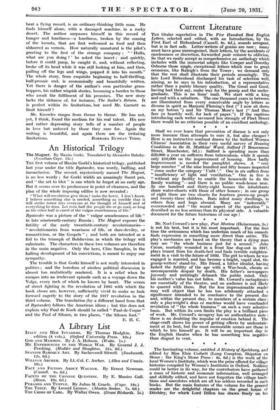An Historical Trilogy
The Magnet. By Maxim Gorki. Translated by Alexander Bakshy. (Jonathan Cape. 15s.)
THE first volume of Maxim Gorki's historical trilogy, published last year under the title Bystander, was wordy, baffling, and inconclusive. The second, mysteriously named The Magnet, is no less wordy ; for Gorki wields an amazingly fluent pen, and " the art to blot " is one which he forgot at an early age. But it scores over its predecessor in point of clearness, and the
plan of the whole imposing edifice is now revealed :
"What will revolution give them ? (asks the hero). I don't know. I believe something else is needed, something 'so terrible that it will strike terror into everyone at the thought of himself and of everything he does. Let even half the people die or go mad, so long as the other half is cured of the vulgar senselessness of life."
Bystander was a picture of the " vulgar senselessness of life " in late nineteenth-century Russia ; The Magnet exposes the futility of the early twentieth-century revolutionaries- " revolutionaries from weariness of life, or dare-devilry, or romanticism, or the Gospels " ; and both are intended as a foil to the triumph of Bolshevism in which the trilogy will culminate. The characters in these two volumes are therefore in the main negative. Only the hero, Clim Samghin, in the halting development of his convictions, is meant to enjoy our
sympathy.
The trouble is that Gorki himself is not really interested in
politics ; and the boredom of aimless political discussion is almost too realistically rendered. It is a relief when he escapes into an irrelevant episode such as a voyage down the Volga, every inch of which he knows by heart. The scenes of street fighting in the revolution of 1905 with which the book closes are, however, sufficiently vivid to make us look forward eagerly to the story of the 1917 revolution in the third volume. The translation (by a different hand from that of Bystander) follows the American idiom ; but this does not explain why Paul de Kock should be called " Paul-de-Coque " and the Pool of Siloam, in two places, "the Siloam font."
E. H. C.










































 Previous page
Previous page